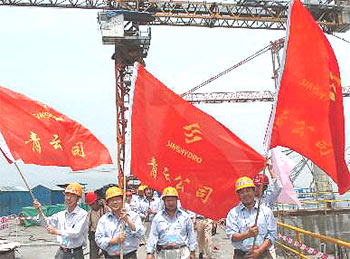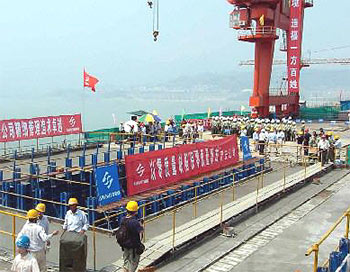| Tools: Save | Print | E-mail | Most Read |
| Three Gorges Dam Completed |
| Adjust font size: |
China completed construction of the world's largest dam today in the Three Gorges area, central China's Hubei Province, signifying a milestone accomplishment of major structure of the mammoth Three Gorges water control project that aims to tame the flood-prone Yangtze River, the nation's longest. At 2:00 PM, the final concrete was poured for the 2,309-meter-long, 185-meter-high main wall of the Three Gorges Dam, which by then began to have capacity of holding water. The concrete placement of the dam's main section was completed 10 months ahead of schedule, which will enable the dam to start its role in power generation, flood control and shipping improvement in 2008, one year ahead of designated time. After the cofferdam is demolished on June 6, the dam's main wall will formally begin to hold water, protecting 15 million people and 1.5 million hectares of farm land downstream against flooding, which had haunted the Yangtze River valley for thousands of years. Upon the demolition, a new landscape featuring a reservoir with a serene water surface behind the spectacular dam will gradually come into being along with planned rises of the water level.
The Three Gorges, which consist of Qutang, Wuxia and Xiling gorges, extend for about 200 km on the upper and middle reaches of the Yangtze. They have become a popular world-class tourist destination noted for beautiful natural landscapes and a great number of historical and cultural relics. This section of the Yangtze has a narrow river course that is inconvenient for shipping but boasts abundant hydroelectric resources. As China's longest and the world's third longest, the Yangtze River, together with the Yellow River, nurtured the Chinese civilization. However, its annual overflow has since long threatened lives and properties of residents along its valley. The latest deluge happened in 1998, which claimed about 1,000 lives and incurred approximately 100 billion yuan (US$12.5 billion) in economic losses. The Three Gorges project was initially envisaged in 1918 by Sun Yat-sen, the forerunner of China's democratic revolution. And after more than half a century's debates and investigation it was finally approved in 1992 by the National People's Congress (NPC), China's top legislature. It is schemed to function in flood control, to generate clean energy and to benefit shipping, with flood control as its major effect. Upon completion in 2008, the project will help the middle and lower reaches of the Yangtze River valley to withstand deluges that can be seen every 100 years. The project, the world's largest, recruited 26,000 people, including professionals and specialists from 50-odd countries and regions, at the peak of its construction. On the basis of absorption of foreign advanced technologies, the project has set 100-plus world records. The project boasts a total electricity generating capacity of 18.2 million kilowatts, an equivalent of the energy produced by a coal mine with an annual production capacity of 50 million tons or by an oilfield with a crude oil output of 25 million tons per year. The project's main dam involves concrete placement of 16 million cubic meters, smashing the 12.57-million-cu-m record set by the Itaipu Hydropower Station on the border of Brazil and Paraguay.
(Xinhua News Agency May 20, 2006) |
| Tools: Save | Print | E-mail | Most Read |
 |
| Related Stories |
| Product Directory China Search |
Country Search Hot Buys |



